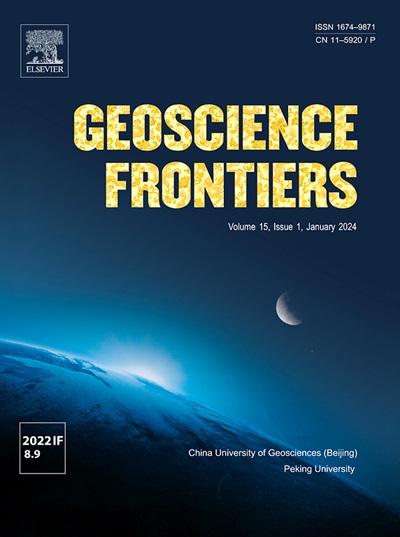将喜马拉雅西部流域尺度的水文与气候参数联系起来:卫星数据、温度指数建模和现场观测的应用
IF 8.5
1区 地球科学
Q1 GEOSCIENCES, MULTIDISCIPLINARY
引用次数: 0
摘要
由于可获得的原位径流时空数据有限,喜马拉雅-喀喇昆仑山(HK)冰川水文学在大尺度和小尺度径流模型研究之间存在着巨大的知识差距。本研究通过应用 1950-2022 年期间的高分辨率冰川水文模型 SPHY(水文空间过程),重建了钱德拉-巴嘎盆地最长的全流域径流序列。利用全流域原位径流(1973-2006 年)和 MODIS 雪盖(2003-2018 年)对模型进行了两级校准。模型验证是根据原位 Chhota Shigri 冰川全流域径流(2010-2015 年)进行的。在 1950-2022 年期间,模拟的全流域年平均径流量为 60.21 ± 6.17 立方米/秒,夏季季风月份径流量最大,7 月份达到峰值(182.69 立方米/秒)。冰川径流(冰川上的融冰+融雪)在径流总量中所占比例最大(39%),其次是非冰川化流域的融雪径流和基流(25%),而降雨径流在径流总量中所占比例最小(11%)。从 2000 年前(59.17 立方米/秒)到 2000 年后(63.47 立方米/秒),径流量明显增加了 7%,这主要是因为 2000 年后融雪开始较早,导致春季水文变化提前了 25 天。由于 RGI 7.0 的冰川化面积较高,与 1950-2022 年人工划定的不同清单相比,RGI 7.0 清单高估了 3%的冰川径流。降水量呈负增长趋势,但总径流量呈正增长趋势,这是由于气温呈正增长趋势,导致过去 72 年流域的冰川径流量和降雨径流量增加。全流域的径流主要受夏季温度的影响,夏季温度直接控制冰川和融雪径流量,夏季降雨则为其提供支持。这项研究强调了在大规模研究中利用原位数据对流域尺度模型进行校核的重要性,并强调了在高海拔喜马拉雅地区进行原位观测的必要性。经流域尺度校准的模型参数可转移到 Chandra-Bhaga 流域内的冰川集水尺度,这表明模型在小集水尺度上具有稳健性。本文章由计算机程序翻译,如有差异,请以英文原文为准。

Linking basin-scale hydrology with climatic parameters in western Himalaya: Application of satellite data, temperature index modelling and in-situ observations
Due to limited spatial and temporal in-situ runoff data availability, Himalaya-Karakoram (HK) glaciohydrology has a significant knowledge gap between large-scale and small-scale runoff modelling studies. This study reconstructs longest basin-wide runoff series in Chandra-Bhaga Basin by applying a high-resolution glaciohydrological model SPHY (Spatial Processes in Hydrology) over 1950–2022. Two-tier model calibration is done using in-situ basin-wide runoff (1973–2006) and MODIS snow cover (2003–2018). Model validation is done against in-situ Chhota Shigri Glacier catchment-wide runoff (2010–2015). The modelled mean annual basin-wide runoff is 60.21 ± 6.17 m3/s over 1950–2022, with maximum runoff in summer-monsoon months, peaking in July (182.69 m3/s). Glacier runoff (ice melt + snowmelt over glacier) contributes maximum (39%) followed by equal contributions from snowmelt runoff from non-glacierized basin area and baseflow (25%), while rainfall-runoff contributes minimum (11 %) to total runoff. There is a significant volumetric increase by ∼7% from pre- (59.17 m3/s) to post-2000 (63.47 m3/s) mainly because of early onset of snowmelt post-2000 that resulted in a hydrograph shift by ∼25 days earlier in spring. The glacier runoff is overestimated by 3% from RGI 7.0 inventory compared to different manually delineated inventories over 1950–2022, because of higher glacierized area from RGI 7.0. The precipitation shows a negative trend, but total runoff shows a positive trend due to positive trend of temperature that resulted in more glacier runoff and rainfall-runoff for basin over last 72 years. Basin-wide runoff is mainly governed by summer temperature which directly controls the amount of glacier and snowmelt runoffs and is supported by summer rainfall. This study highlights importance of basin-scale model calibration with in-situ data in large scale studies and stresses the need for in-situ observations in high-altitude Himalayan region. Basin-scale calibrated model parameters are transferable to glacier catchment scale within Chandra-Bhaga Basin, showing the model robustness at a small catchment scale.
求助全文
通过发布文献求助,成功后即可免费获取论文全文。
去求助
来源期刊

Geoscience frontiers
Earth and Planetary Sciences-General Earth and Planetary Sciences
CiteScore
17.80
自引率
3.40%
发文量
147
审稿时长
35 days
期刊介绍:
Geoscience Frontiers (GSF) is the Journal of China University of Geosciences (Beijing) and Peking University. It publishes peer-reviewed research articles and reviews in interdisciplinary fields of Earth and Planetary Sciences. GSF covers various research areas including petrology and geochemistry, lithospheric architecture and mantle dynamics, global tectonics, economic geology and fuel exploration, geophysics, stratigraphy and paleontology, environmental and engineering geology, astrogeology, and the nexus of resources-energy-emissions-climate under Sustainable Development Goals. The journal aims to bridge innovative, provocative, and challenging concepts and models in these fields, providing insights on correlations and evolution.
 求助内容:
求助内容: 应助结果提醒方式:
应助结果提醒方式:


